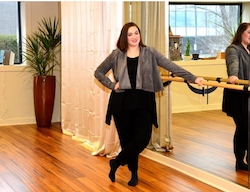Let’s talk about stage fright. Whether you’re new to performing or you’ve been in front of audiences for years, everybody can admit it’s at least a little nerve-wracking. And yet, it’s the culmination of all the work dancers do! So, as a teacher or studio owner who teaches your dancers all about technique and artistry, how can you coach them through the practicalities of performing, like performance anxiety?
Andrea Kolbe, studio owner of Art in Motion Dance Center in Long Island, New York, shares how she spots and soothes students who are feeling nervous. We also spoke with Chicago-based dance/movement therapist Erica Hornthal, author of Body Aware.
Step one is definitely identifying the problem – and it can start even before you get to the theater. Nerves might be affecting your dancer onstage, backstage or even in the studio well before the performance. Is one of your dancers wobblier than usual the week before? Has their attitude changed in rehearsals?
Kolbe says, “When we have our recitals, I can typically tell when the dancers are nervous because of the look on their face and being super jittery. Some will talk excessively, while others will be super quiet and focus inward. I also have some of the dancers verbalize that they are nervous to me or the other instructors backstage.”
If dancers can recognize for themselves and express to you that they’re not feeling their best, that’s fantastic. But it’s important to remember that nerves will look different on everyone. Different methods of dealing with those nerves might work better for some dancers, and other methods for others. Most dancers feel better after testing their shoes onstage and having time to try the choreography in the space. Some may need time and space to focus alone. Others might benefit from a connecting pre-show ritual with their group, like a huddle and pep-talk backstage to connect with their peers.
“Group camaraderie and teamwork definitely ease onstage jitters and nervousness,” notes Kolbe. “I’ve noticed over the past 13 years of teaching in a studio setting that dancers are much more nervous when they are performing a solo on stage.” In the scenario of solos, maybe take your dancer aside and learn what they personally need, whether that’s to burn off some energy, talk it out or do some breathwork.
We asked dance/movement therapist Erica Hornthal for her top three tips on dealing with those pesky jitters in the wings, or nervousness leading up to that moment. Her take?
#1. “Meet your emotions. Identify what/how you feel physically.”
#2. “Notice what the timing, rhythm and intensity of this emotion is. This will help you express it.”
#3. “Express it. This can be through shaking, tapping, jumping, bouncing, etc. There is no wrong movement when it comes to expressing how an emotion feels in your body.”
A simple 1 2 3, right? Well, if you want to make this method its most effective, it takes some practice. Mental health can’t only be addressed by three “top tips” when you’re already in the wings.
“Practice the above sequence at times when you are not feeling stressed, anxious or overwhelmed,” Hornthal encourages. “This will allow you to use it when you really need it.” Some of her other suggestions include moving in unfamiliar ways to build a greater emotional capacity, and checking in with your body regularly to identify emotions as they arise.
It’s about building good mental health habits. Be sure to introduce this to your students before the big day. When they’re feeling fear creep in at the studio, or before bed on recital eve or even when they’re not feeling stressed at all, they should use this method consistently so they know they can rely on it when they’re stepping onstage.
What does Hornthal feel is overlooked about performance anxiety? “Anxiety is a feeling. It’s normal,” she says. “You will never eliminate it. The key is noticing it, understanding it, even befriending it so we can dispel the fear and release the control it has over you. It is not something to be avoided, but rather confronted in a safe and compassionate manner.”
If only we had access to professionals like Hornthal in our studios! Few dance schools have the budget to have a dance/movement therapist on staff, but boy would it be helpful. Kolbe agrees that having a mental health expert come to the studio and give a lecture on recital anxiety would be beneficial to her dancers. If not a guest lecturer, what other mental health resources can we provide for our students? As teachers, it’s our job to set them up to do the best they can – and in a performance art, that includes giving them tools to dance without anxiety affecting their performance.
By Holly LaRoche of Dance Informa.
The post Fighting stage fright: How to spot and soothe performance anxiety appeared first on Dance Informa Magazine.


